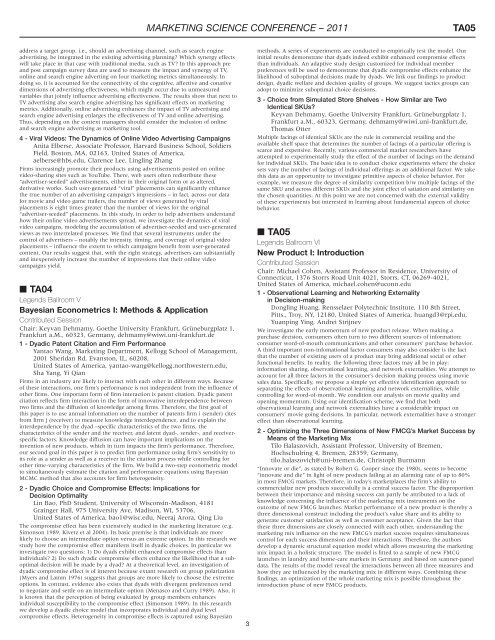2012 INFORMS Marketing Science Conference June 7
2012 INFORMS Marketing Science Conference June 7
2012 INFORMS Marketing Science Conference June 7
You also want an ePaper? Increase the reach of your titles
YUMPU automatically turns print PDFs into web optimized ePapers that Google loves.
address a target group. i.e., should an advertising channel, such as search engine<br />
advertising, be integrated in the existing advertising planning? Which synergy effects<br />
will take place in that case with traditional media, such as TV? In this approach pre<br />
and post campaign survey data are used to measure the impact and synergy of TV,<br />
online and search engine adverting on four marketing metrics simultaneously. In<br />
doing so, it is accounted for the connectivity of the cognitive, affective and conative<br />
dimensions of advertising effectiveness, which might occur due to unmeasured<br />
variables that jointly influence advertising effectiveness. The results show that next to<br />
TV advertising also search engine advertising has significant effects on marketing<br />
metrics. Additionally, online advertising enhances the impact of TV advertising and<br />
search engine advertising enlarges the effectiveness of TV and online advertising.<br />
Thus, depending on the context managers should consider the inclusion of online<br />
and search engine advertising as marketing tool.<br />
4 - Viral Videos: The Dynamics of Online Video Advertising Campaigns<br />
Anita Elberse, Associate Professor, Harvard Business School, Soldiers<br />
Field, Boston, MA, 02163, United States of America,<br />
aelberse@hbs.edu, Clarence Lee, Lingling Zhang<br />
Firms increasingly promote their products using advertisements posted on online<br />
video-sharing sites such as YouTube. There, web users often redistribute these<br />
“advertiser-seeded” advertisements, either in their original form or as altered,<br />
derivative works. Such user-generated “viral” placements can significantly enhance<br />
the true number of an advertising campaign’s impressions – in fact, across our data<br />
for movie and video game trailers, the number of views generated by viral<br />
placements is eight times greater than the number of views for the original<br />
“advertiser-seeded” placements. In this study, in order to help advertisers understand<br />
how their online video advertisements spread, we investigate the dynamics of viral<br />
video campaigns, modeling the accumulation of advertiser-seeded and user-generated<br />
views as two interrelated processes. We find that several instruments under the<br />
control of advertisers – notably the intensity, timing, and coverage of original video<br />
placements – influence the extent to which campaigns benefit from user-generated<br />
content. Our results suggest that, with the right strategy, advertisers can substantially<br />
and inexpensively increase the number of impressions that their online video<br />
campaigns yield.<br />
■ TA04<br />
Legends Ballroom V<br />
Bayesian Econometrics I: Methods & Application<br />
Contributed Session<br />
Chair: Keyvan Dehmamy, Goethe University Frankfurt, Grüneburgplatz 1,<br />
Frankfurt a.M., 60323, Germany, dehmamy@wiwi.uni-frankfurt.de<br />
1 - Dyadic Patent Citation and Firm Performance<br />
Yantao Wang, <strong>Marketing</strong> Department, Kellogg School of Management,<br />
2001 Sheridan Rd, Evanston, IL, 60208,<br />
United States of America, yantao-wang@kellogg.northwestern.edu,<br />
Sha Yang, Yi Qian<br />
Firms in an industry are likely to interact with each other in different ways. Because<br />
of these interactions, one firm’s performance is not independent from the influence of<br />
other firms. One important form of firm interaction is patent citation. Dyadic patent<br />
citation reflects firm interaction in the form of innovative interdependence between<br />
two firms and the diffusion of knowledge among firms. Therefore, the first goal of<br />
this paper is to use annual information on the number of patents firm i (sender) cites<br />
from firm j (receiver) to measure knowledge interdependence, and to explain the<br />
interdependence by the dyad –specific characteristics of the two firms, the<br />
characteristics of the sender and the receiver, and latent dyad-, sender-, and receiverspecific<br />
factors. Knowledge diffusion can have important implications on the<br />
invention of new products, which in turn impacts the firm’s performance. Therefore,<br />
our second goal in this paper is to predict firm performance using firm’s sensitivity to<br />
its role as a sender as well as a receiver in the citation process while controlling for<br />
other time-varying characteristics of the firm. We build a two-step econometric model<br />
to simultaneously estimate the citation and performance equations using Bayesian<br />
MCMC method that also accounts for firm heterogeneity.<br />
2 - Dyadic Choice and Compromise Effects: Implications for<br />
Decision Optimality<br />
Lin Bao, PhD Student, University of Wisconsin-Madison, 4181<br />
Grainger Hall, 975 University Ave, Madison, WI, 53706,<br />
United States of America, bao1@wisc.edu, Neeraj Arora, Qing Liu<br />
The compromise effect has been extensively studied in the marketing literature (e.g.<br />
Simonson 1989, Kivetz et al 2004). Its basic premise is that individuals are more<br />
likely to choose an intermediate option versus an extreme option. In this research we<br />
study how the compromise effect manifests itself in dyadic choices. In particular we<br />
investigate two questions: 1) Do dyads exhibit enhanced compromise effects than<br />
individuals? 2) Do such dyadic compromise effects enhance the likelihood that a suboptimal<br />
decision will be made by a dyad? At a theoretical level, an investigation of<br />
dyadic compromise effect is of interest because extant research on group polarization<br />
(Myers and Lamm 1976) suggests that groups are more likely to choose the extreme<br />
options. In contrast, evidence also exists that dyads with divergent preferences tend<br />
to negotiate and settle on an intermediate option (Menasco and Curry 1989). Also, it<br />
is known that the perception of being evaluated by group members enhances<br />
individual susceptibility to the compromise effect (Simonson 1989). In this research<br />
we develop a dyadic choice model that incorporates individual and dyad level<br />
compromise effects. Heterogeneity in compromise effects is captured using Bayesian<br />
MARKETING SCIENCE CONFERENCE – 2011 TA05<br />
3<br />
methods. A series of experiments are conducted to empirically test the model. Our<br />
initial results demonstrate that dyads indeed exhibit enhanced compromise effects<br />
than individuals. An adaptive study design customized for individual member<br />
preferences will be used to demonstrate that dyadic compromise effects enhance the<br />
likelihood of suboptimal decisions made by dyads. We link our findings to product<br />
design, dyadic welfare and decision quality of groups. We suggest tactics groups can<br />
adopt to minimize suboptimal choice decisions.<br />
3 - Choice from Simulated Store Shelves - How Similar are Two<br />
Identical SKUs?<br />
Keyvan Dehmamy, Goethe University Frankfurt, Grüneburgplatz 1,<br />
Frankfurt a.M., 60323, Germany, dehmamy@wiwi.uni-frankfurt.de,<br />
Thomas Otter<br />
Multiple facings of identical SKUs are the rule in commercial retailing and the<br />
available shelf space that determines the number of facings of a particular offering is<br />
scarce and expensive. Recently, various commercial market researchers have<br />
attempted to experimentally study the effect of the number of facings on the demand<br />
for individual SKUs. The basic idea is to conduct choice experiments where the choice<br />
sets vary the number of facings of individual offerings as an additional factor. We take<br />
this data as an opportunity to investigate primitive aspects of choice behavior. For<br />
example, we measure the degree of similarity competition b/w multiple facings of the<br />
same SKU and across different SKUs and the joint effect of satiation and similarity on<br />
the chosen quantities. At this point we are not concerned with the external validity<br />
of these experiments but interested in learning about fundamental aspects of choice<br />
behavior.<br />
■ TA05<br />
Legends Ballroom VI<br />
New Product I: Introduction<br />
Contributed Session<br />
Chair: Michael Cohen, Assistant Professor in Residence, University of<br />
Connecticut, 1376 Storrs Road Unit 4021, Storrs, CT, 06269-4021,<br />
United States of America, michael.cohen@uconn.edu<br />
1 - Observational Learning and Networking Externality<br />
in Decision-making<br />
Dongling Huang, Rensselaer Polytechnic Institute, 110 8th Street,<br />
Pitts., Troy, NY, 12180, United States of America, huangd3@rpi.edu,<br />
Yuanping Ying, Andrei Strijnev<br />
We investigate the early momentum of new product release. When making a<br />
purchase decision, consumers often turn to two different sources of information:<br />
consumer word-of-mouth communications and other consumers’ purchase behavior.<br />
A third important non-infomational factor consumers may also consider is the fact<br />
that the number of existing users of a product may bring additional social or other<br />
functional benefits. In reality, the following three factors may all be in play:<br />
information sharing, observational learning, and network externalities. We attempt to<br />
account for all three factors in the consumer’s decision making process using movie<br />
sales data. Specifically, we propose a simple yet effective identification approach to<br />
separating the effects of observational learning and network externalities, while<br />
controlling for word-of-month. We condition our analysis on movie quality and<br />
opening momentum. Using our identification scheme, we find that both<br />
observational learning and network externalities have a considerable impact on<br />
consumers’ movie going decisions. In particular, network externalities have a stronger<br />
effect than observational learning.<br />
2 - Optimizing the Three Dimensions of New FMCG’s Market Success by<br />
Means of the <strong>Marketing</strong> Mix<br />
Tilo Halaszovich, Assistant Professor, University of Bremen,<br />
Hochschulring 4, Bremen, 28359, Germany,<br />
tilo.halaszovich@uni-bremen.de, Christoph Burmann<br />
“Innovate or die”, as stated by Robert G. Cooper since the 1980s, seems to become<br />
“innovate and die” in light of new products failing at an alarming rate of up to 80%<br />
in most FMCG markets. Therefore, in today’s marketplaces the firm’s ability to<br />
commercialize new products successfully is a central success factor. The disproportion<br />
between their importance and missing success can partly be attributed to a lack of<br />
knowledge concerning the influence of the marketing mix instruments on the<br />
outcome of new FMCG launches. Market performance of a new product is thereby a<br />
three dimensional construct including the product’s value share and its ability to<br />
generate customer satisfaction as well as customer acceptance. Given the fact that<br />
these three dimensions are closely connected with each other, understanding the<br />
marketing mix influence on the new FMCG’s market success requires simultaneous<br />
control for each success dimension and their interactions. Therefore, the authors<br />
develop a dynamic structural equation model which allows measuring the marketing<br />
mix impact in a holistic structure. The model is fitted to a sample of new FMCG<br />
launches in laundry and home-care markets in Germany and based on scanner-panel<br />
data. The results of the model reveal the interactions between all three measures and<br />
how they are influenced by the marketing mix in different ways. Combining these<br />
findings, an optimization of the whole marketing mix is possible throughout the<br />
introduction phase of new FMCG products.

















